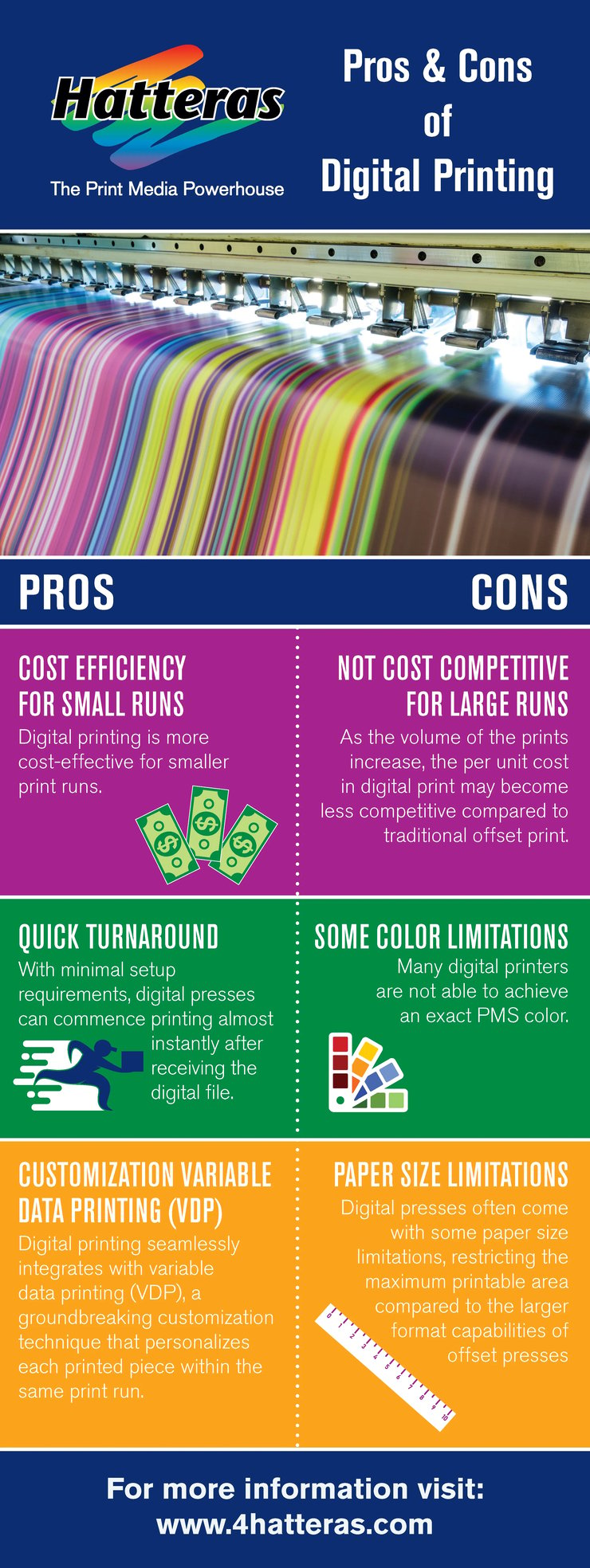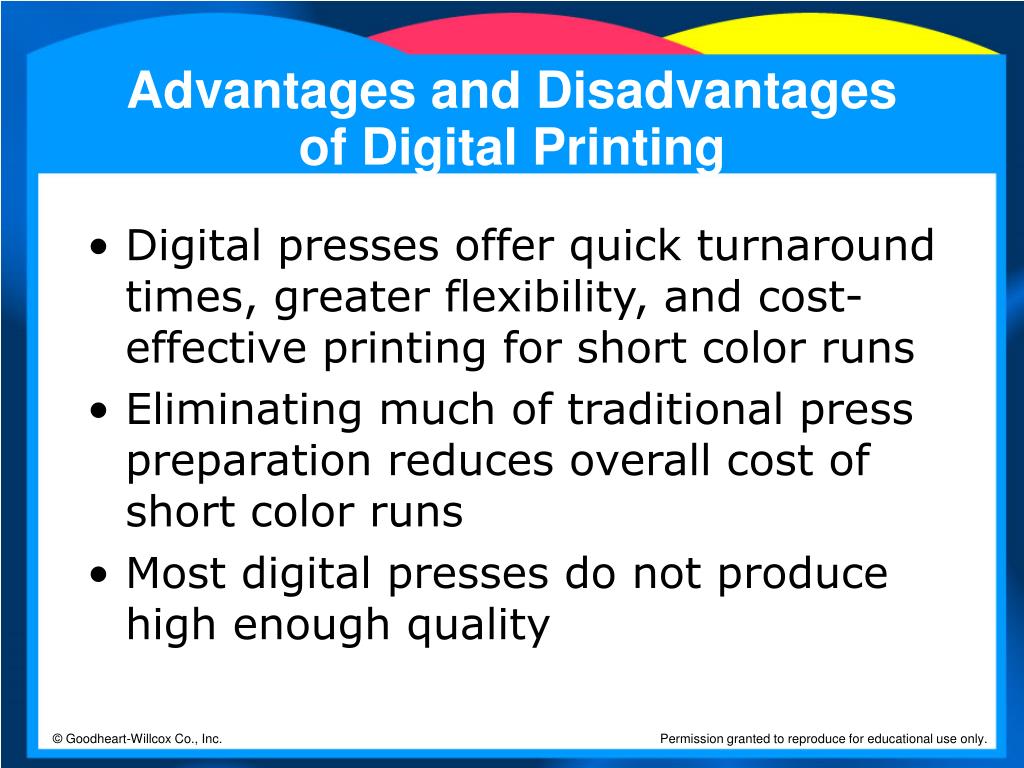The 3-Minute Rule for Digital Printing
Table of ContentsThe Of Digital PrintingThe 30-Second Trick For Digital PrintingThe Best Guide To Digital PrintingDigital Printing Can Be Fun For EveryoneGetting My Digital Printing To WorkThe Only Guide to Digital Printing
has the advantage of only publishing what you require. Countered printing's high configuration expenses avoid it from being cost-effective for runs of 100, 10, or also a solitary copy. A tailored message is constantly well received by customers. Digital printing enables easy customization of advertising products. Smaller sized, more cost-effective sets allow business customize each order. Have a sale for the return to college. You can personalize your e-newsletters for repeat customers by addressing them by name. Variable data printing, such as direct-mail advertising with personalized codes and addresses, is ideally suited for digital printing. Making changes to your layout at the last min is much simpler with electronic printing. It aids in. And this printing approach warranties precision, so layouts will certainly constantly look the exact same. Choices for paper stock, coatings, and various other attributes will certainly continue to expand as technology breakthroughs. When it comes to printing, Seattle Style and Print is among one of the most reliable firms around. Digital quick printing only requires 4 actions of layout, review, printing and binding to get whatever done. Traditional printing covers a big location and needs a large financial investment in technology. The investment of as much as 10sof numerous yuan has made some tiny and medium capitalists dissuaded and powerless. The core of Digital Express is software application. As long as the software application updates can maintain, Digital Express will certainly constantly go to the forefront of the printing market. And a set of software application of several thousand yuan is as well little contrasted to a set of tools of a number of
million yuan. One or 2 people, a lots square meters of storefront, can open up an electronic express printing store. Digital fast printing has an unparalleled benefit: print as needed - Digital Printing. The modern-day company version is versatile and flexible, and it is shown in the printed issue. It
is likely that today's needs are different from the other day.
According to PMMI, digital printing allows brand names and producers to react rapidly to consumer needs while enhancing the supply chain, reducing warehousing price and waste, and enjoying faster time to market. That all audios terrific, yet exactly how does this modern technology do all that? The major differentiator of these modern technologies is that there are no set-up fees and no plates with electronic printing.
10 Easy Facts About Digital Printing Shown
According to Wikipedia, the biggest distinction in between electronic printing and traditional techniques such as lithography, flexography, gravure, or letterpress - Digital Printing is that there is no requirement to replace printing plates in digital printing, whereas in these analog printing approaches home plates are repetitively changed. This causes quicker turnaround time and lowers price when using digital printing.
Fast production implies obtaining your item to market quicker. It also means it's easier and faster to make modifications in the future, when you transform a dish, include a SKU, or produce seasonal packaging. Digital printing is highly adaptable, so it's simple to make adjustments to the bundle layout swiftly. click reference It all returns to the plates.
More stock can mean even more waste down the road. With standard printing techniques, short-run printing is simply not possible. Because a great layout can make or break your product, electronic printing continually develops top quality, clear and vibrant graphics each time. Digital printing on versatile pouches adds the brilliant, dynamic, and accurate graphics that practically bid customers to connect and touch them.
Digital printing is the process of printing digital-based images straight onto a selection of media substratums. There is no requirement for a printing plate, unlike with offset printing. Digital documents such as PDFs or desktop computer publishing documents can be sent out directly to the digital printing press to publish theoretically, picture paper, canvas, fabric, synthetics, cardstock and various other substrates.
Not known Incorrect Statements About Digital Printing
According to PMMI, electronic printing permits brands and suppliers to respond promptly to customer demands while enhancing the supply chain, reducing warehousing expense and waste, and appreciating faster time to market. That all audios terrific, yet how does this modern technology do all that? The significant differentiator of these technologies is that there are no set up fees and no plates with electronic printing.
According to Wikipedia, the best distinction between electronic printing and traditional techniques such as lithography, flexography, gravure, or letterpress is that there is no demand to change printing plates in electronic printing, whereas in these analog printing approaches home plates are repetitively changed. This leads to quicker turnaround time and decreases expense when using electronic printing.

10 Simple Techniques For Digital Printing
With conventional printing methods, short-run printing is simply not feasible. i thought about this Since a terrific design can make or damage your item, electronic printing regularly develops top quality, clear and vivid graphics each time.

According to PMMI, digital printing enables brands and makers to respond swiftly to client needs while improving the supply chain, decreasing warehousing price and waste, and delighting in faster time to market. That all noises wonderful, yet how does this technology do all that? The major differentiator of these click this link innovations is that there are no set-up costs and no plates with digital printing.
An Unbiased View of Digital Printing
According to Wikipedia, the best distinction in between electronic printing and conventional methods such as lithography, flexography, gravure, or letterpress is that there is no demand to change printing plates in digital printing, whereas in these analog printing techniques home plates are continuously changed. This results in quicker turn-around time and reduces price when using electronic printing.
Quick production indicates getting your item to market faster. It also indicates it's much easier and faster to make modifications later, when you change a recipe, include a SKU, or create seasonal packaging. Digital printing is highly flexible, so it's very easy to make changes to the bundle design quickly. It all returns to home plates.

8 Easy Facts About Digital Printing Shown
Digital printing is the process of printing digital-based photos directly onto a range of media substrates. There is no demand for a printing plate, unlike with balanced out printing. Digital files such as PDFs or desktop publishing files can be sent out straight to the digital printing press to publish theoretically, photo paper, canvas, fabric, synthetics, cardstock and other substrates.